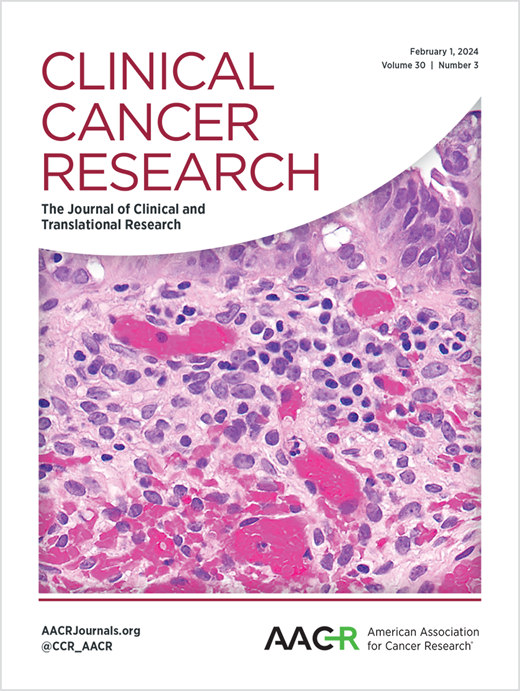对犬骨肉瘤和人类骨肉瘤的大规模比较分析发现了保守的临床相关肿瘤微环境亚型。
IF 10.2
1区 医学
Q1 ONCOLOGY
引用次数: 0
摘要
目的骨肉瘤是一种侵袭性骨癌,缺乏用于个性化治疗的可靠生物标志物。尽管它在人类中很少见,但在成年宠物狗中却相对常见。本研究旨在分析犬类和人类骨肉瘤患者的临床注释大容量肿瘤转录组数据集,以确定疾病进展的潜在保守模式。实验设计使用去卷积法分析了245只宠物狗的大容量转录组数据,这些宠物狗患有治疗无效的阑尾骨肉瘤,以确定肿瘤微环境(TME)的特征。对同一只宠物狗的原发性肿瘤和转移性肿瘤的肿瘤微环境进行了比较,并评估了肿瘤微环境对宠物狗生存期的影响。根据犬肿瘤数据推断出的肿瘤微环境组成,开发了一种机器学习模型来对肿瘤微环境进行分类。该模型被应用于 8 个独立的人类骨肉瘤数据集,以评估其通用性和预后价值。结果这项研究根据大块肿瘤样本的细胞类型组成发现了犬骨肉瘤的三种不同的 TME 亚型:免疫富集(IE)、免疫富集致密细胞外基质样(IE-ECM)和免疫荒漠(ID)。这三种基于TME的犬骨肉瘤亚型在人类中是保守的,可以预测人类患者的无进展生存结果,而不受传统预后因素(如标准化疗后肿瘤坏死的百分比和诊断时的疾病分期)的影响。这些发现证明了利用犬自然发生的癌症数据来模拟人类骨肉瘤TME复杂性的潜力,为发现新型生物标记物和开发更有效的精准肿瘤治疗方法提供了一条前景广阔的途径。本文章由计算机程序翻译,如有差异,请以英文原文为准。
Large Scale Comparative Analysis of Canine and Human Osteosarcomas Uncovers Conserved Clinically Relevant Tumor Microenvironment Subtypes.
PURPOSE
Osteosarcoma is an aggressive bone cancer lacking robust biomarkers for personalized treatment. Despite its scarcity in humans, it is relatively common in adult pet dogs. This study aimed to analyze clinically annotated bulk tumor transcriptomic datasets of canine and human osteosarcoma patients to identify potentially conserved patterns of disease progression.
EXPERIMENTAL DESIGN
Bulk transcriptomic data from 245 pet dogs with treatment-naïve appendicular osteosarcoma were analyzed using deconvolution to characterize the tumor microenvironment (TME). The TME of both primary and metastatic tumors derived from the same dog was compared, and its impact on canine survival was assessed. A machine learning model was developed to classify the TME based on its inferred composition using canine tumor data. This model was applied to 8 independent human osteosarcoma datasets to assess its generalizability and prognostic value.
RESULTS
This study found three distinct TME subtypes of canine osteosarcoma based on cell type composition of bulk tumor samples: Immune Enriched (IE), Immune Enriched Dense Extra-Cellular Matrix-like (IE-ECM), and Immune Desert (ID). These three TME-based subtypes of canine osteosarcomas were conserved in humans and could predict progression-free survival outcomes of human patients, independent of conventional prognostic factors such as percent tumor necrosis post standard of care chemotherapy treatment and disease stage at diagnosis.
CONCLUSIONS
These findings demonstrate the potential of leveraging data from naturally occurring cancers in canines to model the complexity of the human osteosarcoma TME, offering a promising avenue for the discovery of novel biomarkers and developing more effective precision oncology treatments.
求助全文
通过发布文献求助,成功后即可免费获取论文全文。
去求助
来源期刊

Clinical Cancer Research
医学-肿瘤学
CiteScore
20.10
自引率
1.70%
发文量
1207
审稿时长
2.1 months
期刊介绍:
Clinical Cancer Research is a journal focusing on groundbreaking research in cancer, specifically in the areas where the laboratory and the clinic intersect. Our primary interest lies in clinical trials that investigate novel treatments, accompanied by research on pharmacology, molecular alterations, and biomarkers that can predict response or resistance to these treatments. Furthermore, we prioritize laboratory and animal studies that explore new drugs and targeted agents with the potential to advance to clinical trials. We also encourage research on targetable mechanisms of cancer development, progression, and metastasis.
 求助内容:
求助内容: 应助结果提醒方式:
应助结果提醒方式:


